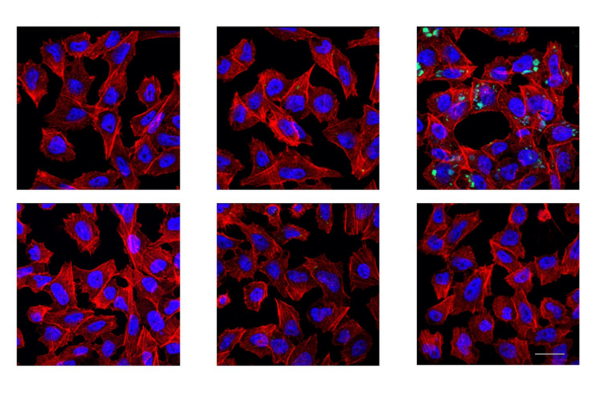.png)
Researchers unravel complexities of Alzheimer’s disease in protein fragments and plaque diversity
Leuven, 18 June 2024 - Alzheimer's disease (AD) remains one of the most challenging and prevalent neurodegenerative disorders, affecting millions worldwide. In two recent studies, researchers led by Prof. Lucía Chávez Gutiérrez (VIB-KU Leuven), Prof. William Mobley (UCSD, USA), and Prof. Carsten Hopf (CeMOS, Mannheim, Germany) shed light on the role of toxic protein fragments and plaque composition in AD, offering valuable insights for future research and potential treatments.
One of the key visible features in the brains of individuals with Alzheimer's disease (AD) is the presence of amyloid plaques. These plaques are formed in the neurons and consist of clumps of misfolded β-amyloid fragments (Aβ). These fragments are degradation products of amyloid precursor protein (APP), which is located in the cell membranes of brain cells. The brain continually produces new APP molecules while breaking down and removing old ones. This ‘waste disposal’ process involves enzymatic cleavage, with gamma-secretase as the enzyme that produces the well-known toxic Aβ peptides in AD.
The lab of Prof. Lucía Chávez Gutiérrez at the VIB-KU Leuven Center for Brain & Disease Research is focused on understanding the role of protein cleavage in the molecular mechanisms underlying AD. Two new studies by her team now provide a significant step forward in understanding the role of gamma-secretase inhibition and the relevance of amyloid plaque composition.
Hacking the enzymatic scissor
The first study, published in eLife, uncovers a novel way in which Aβ42, Aβ -fragments with a length of 42 building blocks (amino acids), contributes to neuronal physiology and potentially to neurodegeneration. The study reveals that Aβ42 can impede gamma-secretase function, which is essential for cells.
“Besides the breakdown of APP, gamma-secretase is also crucial for normal cell signaling," explains Dr. Katarzyna Zoltowska, first author of the study. "We discovered that Aβ42 binds to and inhibits gamma-secretase, leading to a build-up of other toxic cellular materials which may ultimately cause neuronal death. Our findings suggest that Aβ42 can worsen Alzheimer's disease not just by accumulating in plaques but also by directly interfering with cellular processes.”
Dr. Utpal Das (UCSD, USA), who also contributed to the study, added: "The researchers can now explore ways to prevent Aβ42 from inhibiting gamma-secretase, thereby potentially restoring normal cellular communication.”.
Diversity within plaques
The second study, a collaboration between VIB-KU Leuven and the Center for Mass Spectrometry and Optical Spectroscopy (CeMOS) at Mannheim University of Applied Sciences and published in Analytical Chemistry, tackles the question of plaque heterogeneity. Traditionally, amyloid plaques have been viewed as uniform entities. However, a powerful new technique called multimodal mass spectrometry imaging combined with machine learning and operated in the Hopf lab revealed a surprising level of diversity among these plaques.
"Our research completely redefines our understanding of amyloid plaques," says Dr. Thomas Enzlein, first author of the study. "By analyzing individual plaques at the single-molecule level, we discovered that their compositions vary quite a bit. Plaques contain different levels of Aβ and other fatty molecules called lipids. Moreover, the specific makeup seems to differ significantly between patients with full-blown AD and those who have amyloid deposits but no cognitive decline."
The ability to differentiate between "harmful" and "benign" plaques based on their molecular fingerprint holds great potential for the development of precise diagnostic tools that can distinguish between individuals at risk of cognitive decline and those who may not progress to AD. Additionally, it paves the way for targeted therapies that address specific plaque compositions.
A multifaceted approach to combat Alzheimer's
These findings highlight the complex nature of AD and the need for a multifaceted approach to tackling the disease.
Prof. Lucía Chávez Gutiérrez: ”More research is needed, but by understanding how Aβ disrupts cellular functions and the variations within amyloid plaques, we can develop better strategies to combat this devastating disease.”
Publications
Alzheimer’s disease linked Aβ42 exerts product feedback inhibition on γ-secretase impairing downstream cell signaling. Zoltowska , et al. eLife, 2024. DOI: 10.7554/eLife.90690.2.
Integrative Single-Plaque Analysis Reveals Signature Aβ and Lipid Profiles in the Alzheimer’s Brain. Enzlein, et al. Analytical Chemistry, 2024. DOI: 10.1021/acs.analchem.3c05557.
Funding
The research (team) was supported by the Cure Alzheimer’s Fund (CALF), Klaus-Tschira Foundation and the Federal Ministry of Education and Research (BMBF) within the M2Aind consortium. The research was funded by Foundation Flanders (FWO) and Foundation Recherche Alzheimer - Stichting Alzheimer Onderzoek (STOPALZHEIMER.BE).
India Jane Wise
Joran Lauwers
About the VIB-KU Leuven Center for Brain & Disease Research
Scientists at the VIB-KU Leuven Center for Brain & Disease study how brain cells are organized and how they communicate with each other. These mechanisms reveal and provide insights into what goes wrong in brain diseases such as Alzheimer's, Parkinson's, ALS, and dystonia. This basic work should ultimately lead to new drugs for use against these currently incurable diseases.





